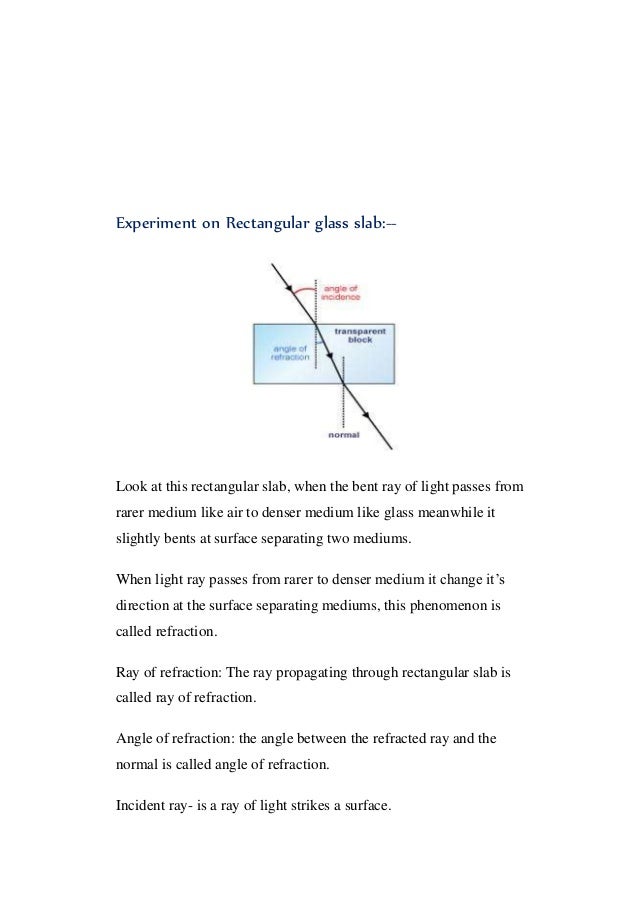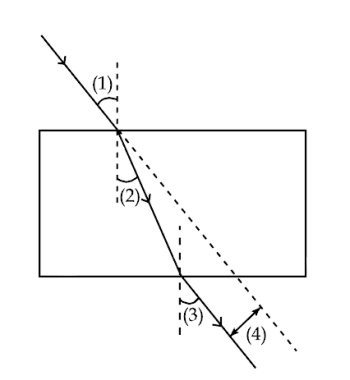Rectangular Glass Slab Experiment
Posted : admin On 09.01.2020Refraction through a glass slab and the refractive index.1.Refraction through aRectangular Glass Slab&The Refractive IndexBy,.Team membersSharanraj(Captain)Sri Ram(Vice-Captain)AdhithDhirajVyshakhBuvaneshwar.What is Refraction?Refraction is the change in direction of propagation ofa wave due to a change in its transmission medium.Laws of RefractionWhen light travels from one medium to another, it generallybends, or refracts. The law of refraction gives us a way ofpredicting the amount of bend. This law is morecomplicated than that for reflection, but an understandingof refraction will be necessary for our future discussion oflenses and their applications. The law of refraction is alsoknown as Snell's law, named for Willobrord Snell, whodiscovered the law in 1621.Snell's law gives the relationshipbetween angles ofincidence and refraction for awave impinging on an interfacebetween two media withdifferent index of refraction. Thelaw follows from the boundarycondition that a wave becontinuous across a boundary,which requires that the phase ofthe wave be constant on any givenplane, resulting inLaws of Refraction.When we talk about thespeed of light, we're usuallytalking about the speed oflight in a vacuum, which is3.00 x 108 m/s. When lighttravels through somethingelse, such as glass, diamond,or plastic, it travels at adifferent speed.
Rectangular Glass Slab Experiment Chart
As performed in the real lab: Apparatus:A drawing board, rectangular glass slab, office pins, sheet of white paper, a protractor and sharply pointed pencil. Procedure:. Fix a sheet of white paper on a drawing board with drawing pins. Place the given glass slab nearly in the middle of the sheet.
Mark the boundary of the glass slab with a sharp pencil and label it as PQRS after removing the slab from its position. On the line PQ mark a point E and draw a normal N1EN2 at it. Draw a line AE making angle AEN1 with the normal.The angle should neither too small nor too large (say about 40 degree). Now place the glass slab again on its boundary PQRS and fix two pins A and B vertically about 10 cm apart on the line AE (say points A and B). Look through the glass slab along the plane of the paper from the side SR and move your head until the images of the two pins A and B are seen clearly. Closing your one eye,adjust the position of your head in such a way that the images of the pins A and B lie in the same straight line.


Fix two other pins C and D vertically in such a way that the images of the pins A and B and pins C and D, all these four, lie in the same straight line. Ensure that the feet of the pins ( not their heads ) lie in the same straight line. Remove the slab and also the pins from the board and encircle the pin-pricks on the paper,with a sharp pencil. Join the points D and C and produce the line DC towards the slab so that it meets the boundary line RS at the point F. Join the points e and F.

Thus for the incident ray represented by line AE, the refracted ray and the emergant ray are represented by EF and FD respectively. On the line RS draw a normal N1'FN2' at point F.